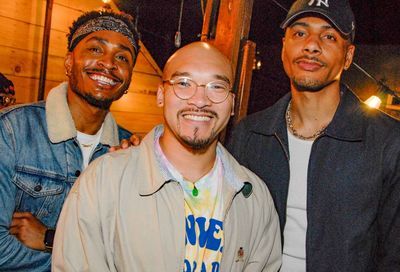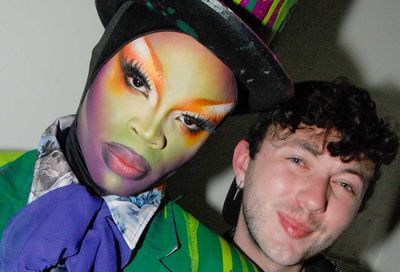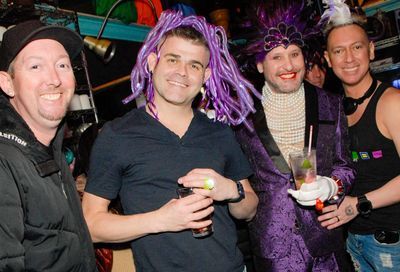I Remember Nomi
New Wave surfer Klaus Nomi catches a posthumous second wave in Andrew Horn’s engaging biopic, 'The Nomi Song'
There is a cliché in the popular-culture lexicon: the German performance artist. Klaus Nomi is one of the pillars of this oft-parodied caricature, though his own expression was something unarguably original.
With his avant-garde-alien packaging, there was some playful speculation that Klaus Nomi may have been from another planet or another time. Revisiting the singer’s life in The Nomi Song: The Klaus Nomi Odyssey, a new biopic directed by Andrew Horn is a similar experience, transporting audiences to a distant locale. Not only does it remind us — or show some of us for the first time — that Nomi was a unique delicacy, but how surreal was this small sliver of Manhattan-centered social history from the late 1970s to the early 1980s.
"He came from outer space to save the human race," is the film’s opening line, as well as its marketing tagline. Actually, Nomi — whose real name was Klaus Sperber — came from Germany. Born shortly before the end of World War II, Nomi secured his entry into the world at a pivotal time in history. The Third Reich was crumbling, but a new world was dawning. Nomi’s art was similarly conflicted, with wonderful results that looked like 1930s-era Marlene Dietrich joining the cast of The Rocky Horror Picture Show. Silk meets plastic.
 |
Now, some 20 years later, The Nomi Song resurrects this funny little man who has largely slipped through history’s fingers, tugging at us to give Nomi his due and recognize his New Wave legacy. Over the course of 96 minutes, Horn delivers interviews with artistic stars of turn-of-the-decade Manhattan, footage of interviews with Nomi himself, a recorded interview with Nomi’s aunt to fill in bits of his childhood and family life, and great TV footage.
Foremost, there is the infamous appearance on Saturday Night Live. As if David Bowie onstage in a dress wasn’t too much for 1979 America, there was Nomi — along with drag-diva-to-be Joey Arias — as backup in a stretchy, structured black bodysuit of artificial proportions. This was nationally televised proof that the New Wave was coming.
As for the interviews, the likes of Ann Magnuson and Kenny Scharf illustrate the incestuous nature of celebrity. While — like Nomi — she’s far from a household name, Magnuson has appeared in piles of movies. The year Nomi died, for example, David Bowie was slashing her throat in The Hunger. Perhaps you remember her as the bitchy boss on Anything But Love, the Jamie Lee Curtis sitcom? Magnuson retells her first encounter with unknown Nomi, before insisting that he join her New Wave vaudeville show.
Artist Kenny Scharf, contemporary of Jean-Michel Basquiat and Keith Haring, still enjoys some celebrity. Long ago, as he recalls for Horn, he shared a courtyard with Nomi. In summer evenings, he would hear Nomi practicing his other-worldly counter-tenor singing through his open window.
|
The most touching moments of the documentary go to Nomi himself. Footage of him walking through urban landscape in sunglasses and a fedora, talking about his musical roots is a moving glimpse behind the plastic façade.
"There was always this collision between opera and pop," says Nomi in German. "When I was a kid, I stole money from my mother — I think she’s still mad at me — so I could buy a record of Elvis Presley’s ‘King Creole.’ And she was really angry. She hated rock and roll. So she took it away and got me Maria Callas instead. And there I was, caught between two extremes."
What Nomi gave audiences was generally one extreme, all his own. In his plastic tuxedo, black-and-white makeup, or some other manifestation of his angular, pop-futuristic aesthetic, he wowed audiences. But almost as soon as it began, it was over.
Nomi’s recollections may provide the film’s most touching moments, but it’s others’ recollections of his death that will haunt viewers. A pioneer to the end, Nomi was in the first wave of AIDS-related deaths.
Advertisement
|
"The disease was so new," says Tony Frere, one of Nomi’s performers, remembering when he and Nomi first heard of the tell-tale skin lesions. "We were both watching the news at the same moment — he was in the hospital, I was at my apartment. And he was, ‘Oh, my God. I have these. I have this on my arm. I have this."
Depending on a viewer’s age, Nomi Song may illicit very different moods. Younger viewers — say, those born after Nomi’s death in 1983 — may feel distant enough from the subject to feel as though they’re on a fun exploration of camp and kitsch. For GenX and older, there is something somber about any trip back to early ’80s Manhattan that saw the dawn of gay liberation quickly eclipsed by AIDS.
Support Metro Weekly’s Journalism
These are challenging times for news organizations. And yet it’s crucial we stay active and provide vital resources and information to both our local readers and the world. So won’t you please take a moment and consider supporting Metro Weekly with a membership? For as little as $5 a month, you can help ensure Metro Weekly magazine and MetroWeekly.com remain free, viable resources as we provide the best, most diverse, culturally-resonant LGBTQ coverage in both the D.C. region and around the world. Memberships come with exclusive perks and discounts, your own personal digital delivery of each week’s magazine (and an archive), access to our Member's Lounge when it launches this fall, and exclusive members-only items like Metro Weekly Membership Mugs and Tote Bags! Check out all our membership levels here and please join us today!
























